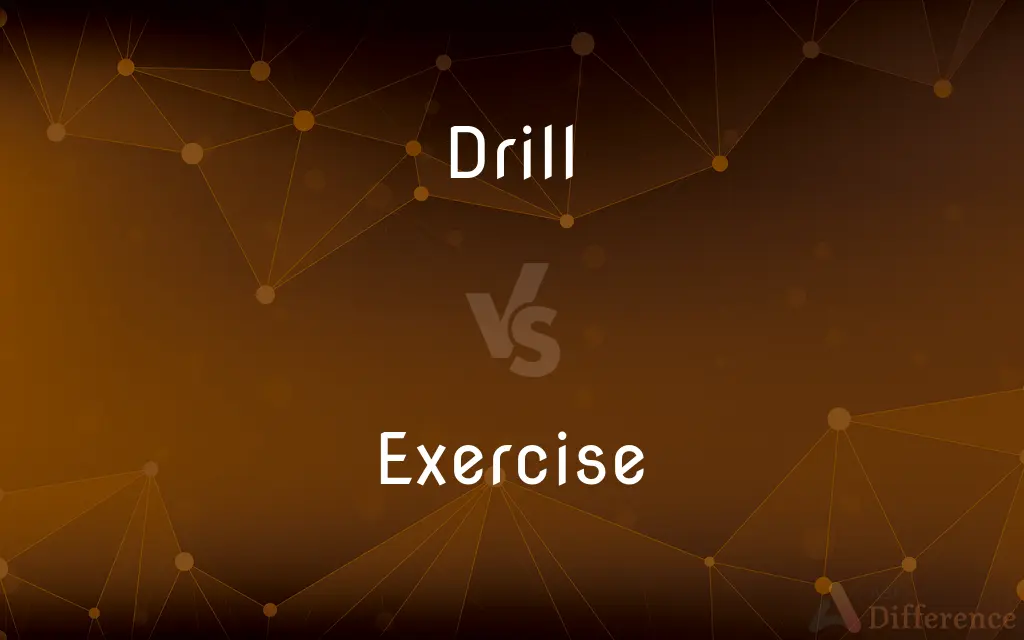Drill vs. Exercise — What's the Difference?
Edited by Tayyaba Rehman — By Fiza Rafique — Updated on February 29, 2024
"Drill" refers to repetitive training for skill development or emergency preparedness, focusing on efficiency and response. "Exercise" encompasses broader physical or mental activities for health, skill, or educational purposes, emphasizing practice.

Difference Between Drill and Exercise
Table of Contents
ADVERTISEMENT
Key Differences
A drill is a specific type of training activity characterized by repetition and often used to instill a particular skill or behavior, such as military drills or fire drills. These activities are designed to prepare individuals for specific situations, ensuring that responses become almost automatic. Exercise, on the other hand, refers to a wider range of physical or mental activities aimed at improving health, fitness, or cognitive abilities. Unlike drills, exercises can be varied and tailored to individual goals, such as strength training, cardiovascular health, or learning a new language.
Drills are structured and focused, aiming for precision and quickness in execution. The purpose of exercise is broader, focusing on overall development and maintenance rather than specific response training.
Drills are often mandatory and have a clear, practical objective (e.g., safety procedures, military readiness), exercises can be optional and self-directed, motivated by personal health, educational goals, or enjoyment. The context in which these terms are used reflects their purposes: drills for immediate and effective action in specific scenarios, and exercises for ongoing, holistic development.
The intensity and duration of drills and exercises can differ significantly. Drills are usually intense, short, and focused on mastering a specific action or procedure. Exercises can be more flexible, ranging from short, high-intensity workouts to longer sessions aimed at endurance or comprehensive learning over time.
Despite their differences, both drills and exercises are crucial for development, whether for preparing for emergencies, improving physical health, enhancing skills, or fostering educational growth. The choice between a drill and an exercise depends on the desired outcome, whether it's to perfect a specific response or to achieve broader health or educational goals.
ADVERTISEMENT
Comparison Chart
Purpose
To instill specific skills or behaviors through repetition
To improve or maintain health, fitness, or skills
Scope
Narrow, focused on specific responses or procedures
Broad, covering a wide range of physical or mental activities
Context
Often used in emergency preparedness, military training
Used in health, fitness, education, and personal development
Volition
Typically mandatory and structured
Often voluntary and flexible
Outcome
Immediate and effective action in specific scenarios
Overall development and maintenance of abilities
Compare with Definitions
Drill
A method to instill automatic response through practice.
Soldiers undergo drills to react instinctively in combat.
Exercise
Practice tasks to enhance learning and cognitive skills.
Language learning exercises help improve vocabulary and grammar.
Drill
Structured and focused training sessions.
The basketball team's shooting drill improved their accuracy.
Exercise
Physical or mental activity for health and skill improvement.
She does yoga exercises to improve her flexibility.
Drill
Exercises designed for readiness and precision.
The school conducts earthquake drills to prepare students for natural disasters.
Exercise
Varied routines for overall physical well-being.
Aerobic exercises are essential for cardiovascular health.
Drill
Repetitive training for specific skills or emergency responses.
The fire drill ensured everyone knew the evacuation route.
Exercise
Engagements in activities for enjoyment and development.
Musical exercises on the piano enhance dexterity and musicality.
Drill
Practice aimed at efficiency and quick response.
Emergency drills are conducted to minimize response times during crises.
Exercise
Activities aimed at personal fitness goals.
His daily exercise routine includes running and weightlifting.
Drill
A drill or drilling machine is a tool primarily used for making round holes or driving fasteners. It is fitted with a bit, either a drill or driver, depending on application, secured by a chuck.
Exercise
Exercise is any bodily activity that enhances or maintains physical fitness and overall health and wellness.It is performed for various reasons, to aid growth and improve strength, prevent aging, develop muscles and the cardiovascular system, hone athletic skills, weight loss or maintenance, improve health, or simply for enjoyment. Many individuals choose to exercise outdoors where they can congregate in groups, socialize, and enhance well-being.In terms of health benefits, the amount of recommended exercise depends upon the goal, the type of exercise, and the age of the person.
Drill
A tool or machine with a rotating cutting tip or reciprocating hammer or chisel, used for making holes.
Exercise
Activity requiring physical effort, carried out to sustain or improve health and fitness
Loosening-up exercises
Exercise improves your heart and lung power
Drill
Instruction or training in military exercises
Parade-ground drill
Exercise
An activity having a specified aspect
An undertaking that was an exercise in futility.
Drill
To entice; to allure from step; to decoy; - with on.
See drilled him on to five-fifty.
Exercise
Carry out or practice; as of jobs and professions;
Practice law
Drill
Learn by repetition;
We drilled French verbs every day
Pianists practice scales
Exercise
Do physical exercise;
She works out in the gym every day
Common Curiosities
Can a drill be considered an exercise?
Yes, a drill can be considered a form of exercise, especially when it involves physical activity, but it is more specific in its objectives.
Why are drills important in emergency situations?
Drills prepare individuals to respond quickly and effectively in emergencies, minimizing panic and confusion.
How does variety in exercise benefit an individual?
Variety in exercise prevents boredom, targets different muscle groups, and addresses multiple aspects of physical and mental health.
Are drills only used in emergencies or military settings?
While common in these settings, drills are also used in sports, schools, and other areas to instill specific behaviors or responses.
Can exercise be a form of therapy?
Yes, exercise is often used as part of therapy for various physical and mental health conditions, known as exercise therapy.
Can exercises be tailored to individual needs?
Yes, exercises can and should be tailored to fit individual health, fitness levels, and personal goals for maximum benefit.
Are exercises always physical?
No, exercises can also be mental, such as cognitive exercises for the brain or educational tasks.
Is participation in drills voluntary?
Participation in drills, especially those related to safety or military training, is often mandatory to ensure preparedness.
What role does repetition play in drills?
Repetition in drills helps to build muscle memory and automaticity, ensuring the skill or response is executed effectively when needed.
How do drills enhance performance in sports?
Drills in sports focus on specific skills, improving players' efficiency, reaction times, and overall performance through repetition.
How are drills evaluated for effectiveness?
Drills are evaluated through observation, feedback, and sometimes simulations to assess whether the desired outcomes are achieved.
Can exercise improve mental health?
Yes, physical exercise has been shown to improve mental health by reducing symptoms of depression, anxiety, and stress.
How often should one exercise for optimal health?
Guidelines typically recommend at least 150 minutes of moderate aerobic activity or 75 minutes of vigorous activity per week, plus muscle-strengthening exercises on two or more days a week.
Is it possible to over-exercise?
Yes, over-exercising can lead to injuries, burnout, and other health issues. Balance and rest are important.
Do drills change over time?
Drills may be updated or modified based on new insights, technologies, or strategies to ensure they remain effective.
Share Your Discovery

Previous Comparison
Prawn vs. Crab
Next Comparison
Motive vs. IntentAuthor Spotlight
Written by
Fiza RafiqueFiza Rafique is a skilled content writer at AskDifference.com, where she meticulously refines and enhances written pieces. Drawing from her vast editorial expertise, Fiza ensures clarity, accuracy, and precision in every article. Passionate about language, she continually seeks to elevate the quality of content for readers worldwide.
Edited by
Tayyaba RehmanTayyaba Rehman is a distinguished writer, currently serving as a primary contributor to askdifference.com. As a researcher in semantics and etymology, Tayyaba's passion for the complexity of languages and their distinctions has found a perfect home on the platform. Tayyaba delves into the intricacies of language, distinguishing between commonly confused words and phrases, thereby providing clarity for readers worldwide.















































